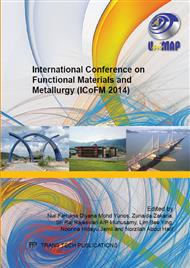p.161
p.167
p.173
p.179
p.185
p.189
p.193
p.198
p.204
Single-Walled Carbon Nanotubes – Graphene Mixture as a Dye Monolayer for Dye-Sensitized Solar Cells
Abstract:
The suspension of single-walled carbon nanotubes (SWCNTs) was produced by acid functionalization process. After that, the reduced graphene oxide (r-GO) suspension was added into SWCNTs suspension in order to produce a solution of SWCNTs-Graphene mixture. The solution of SWCNTs-Graphene mixture was then deposited onto titanium dioxide (TiO2) layer as a dye monolayer in dye-sensitized solar cell (DSSC) device using drop – casting methods. Beforehand, the TiO2 layer was cured with two different temperatures which was 450°C and 550°C. The electrical properties of the device, including the response and efficiency, were studied and compared with different curing temperatures.
Info:
Periodical:
Pages:
185-188
Citation:
Online since:
June 2015
Authors:
Price:
Сopyright:
© 2015 Trans Tech Publications Ltd. All Rights Reserved
Share:
Citation:


